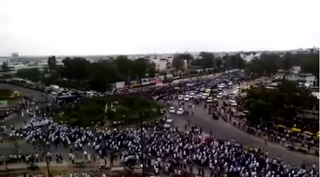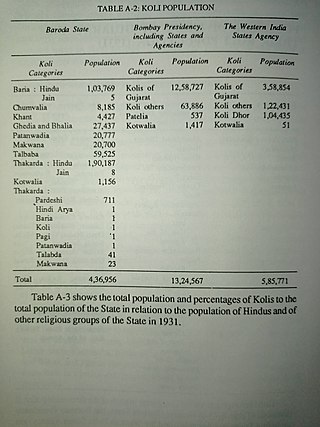Related Research Articles
Patel is an Indian surname or title, predominantly found in the state of Gujarat, representing the community of land-owning farmers and later businessmen, agriculturalists and merchants. Traditionally the title is a status name referring to the village chieftains during medieval times, and was later retained as successive generations stemmed out into communities of landowners. There are roughly 500,000 Patels outside India, including about 150,000 in the United Kingdom and about 150,000 in the United States. Nearly 1 in 10 people of Indian origin in the US is a Patel.
Parmar, also known as Panwar or Pawar, is a Rajput clan found in Northern and Central India, especially in Rajasthan, Gujarat, Punjab, Haryana, Uttarakhand, Uttar Pradesh, Bihar, Madhya Pradesh and North Maharashtra. The clan name is also used by Kōḷīs, Garoḍās, Līmaciyā Valands, Mōcīs, Tūrīs, Luhārs, Kansārās, Darajīs, Bhāvasārs, Cūnvāḷiyās, Ghañcīs, Harijans, Sōnīs, Sutārs, Dhobīs, Khavāsas, Rabārīs, Āhīrs, Sandhīs, Pīñjārās, Vāñjhās, Dhūḷadhōyās, Rāvaḷs, Vāgharīs, Bhīls, Āñjaṇās, Mer and Ḍhēḍhs.

Patidar, formerly known as Kanbi, is an Indian land-owning and peasant caste and community native to Gujarat. The community comprises at multiple subcastes, most prominently the Levas and Kadvas. They form one of the dominant castes in Gujarat. The title of Patidar originally conferred to the land owning aristocratic class of Gujarati Kanbis; however, it was later applied en masse to the entirety of the Kanbi population who lay claim to a land owning identity, partly as a result of land reforms during the British Raj.
The Gujarat Kshatriya Sabha was a social organisation in the Indian state of Gujarat which was initiated to get together the Kolis and Rajputs of the state. Gujarat Kshatriya Sabha was started by a Koli Jagirdar Natvarsinh Solanki and a Rajput Mahendrasinh Mahida to resolve the problems faced by both communities and to be in power at political level. The Gujarat Kshatriya Sabha was most important for Rajputs to be in power at political level because they were only 4% of the total population of Gujarat while Kolis were largest caste cluster comprising the 24% of total population of state.
Chimanbhai Patel was an Indian politician associated with Indian National Congress and Janata Dal, and a former Chief Minister of Gujarat state in India representing both those parties at various times. Patel is known as the founder of Kokam Theory which was initiated to counter the Kham Theory of Indian National Congress and it was very successful in Saurashtra and South Gujarat to achieve the huge support from Kolis which were 24% of the state population.

The Pateliya, or Patelia or Patel is a landowning Subcaste of Koli caste found in the Indian states of Gujarat. During the British Raj in India, Patelia Kolis served as tax collectors and administrators. The name Patelia comes from a word meaning village chief. Many Patelia Kolis also went into business and commerce during the Raj period. Patelia Kolis are part of Talapada Kolis of Gujarat.

The Rathva or Rathwa also spelled as Rathava and Rathawa is a Subcaste of the Koli caste found in the Indian state of Gujarat. Rathava Kolis were agriculturist by profession and turbulent by habits but now lives like Adivasis such as Bhil because of their neighborhood
The Kotwal also spelled as Cotwal, or Kotval, was a title used in medieval and early modern period for the leader of a Kot or fort. Kotwals often controlled the fort of a major town or an area of smaller towns on behalf of another ruler. It was similar in function to a British Indian Zaildar From Mughal times the title was given to the local ruler of a large town and the surrounding area. However, the title is also used for leaders in small villages as well. Kotwal has also been translated as Chief police officer. The post of Kotwal was known since ancient times as Kota pala who was the chief of Police.
The Vala, or Wala is a Gujarati clan (Gotra) mostly found among Koli, Rajput and Kathi castes of Gujarat.

The Thakor Koli, or Thakore Koli, is a subcaste of the Koli caste of Gujarat. Koli people form the largest caste-cluster in Gujarat, comprising 24 per cent of the total population of the state. Koli Thakors in Gujarat are classified as Other Backward Class (OBC). During his tenure, the former chief minister, Koli community member Madhav Singh Solanki, included all Koli communities of Gujarat in the OBC. Koli Thakors are mostly cultivators or small land-owners.

Baria, or Baraiya,Bareeya and Bariya is a clan (Gotra) of the Koli caste found in the Indian State of Gujarat and Dadra and Nagar Haveli and Daman and Diu. the Devgad Baria was their Stronghold or given their name to Baria State in Gujarat. according to the historian Y.V.S Nath, the ruling royal family of Baria State is original Koli by caste but later they claimed to be of Rajput origin to be in high status among other Princely States.

The Koli is an Indian caste found in Rajasthan, Himachal Pradesh, Gujarat, Maharashtra, Uttar Pradesh, Haryana, Karnataka, Odisha and Jammu and Kashmir states in India. Koli is an agriculturist caste of Gujarat but in coastal areas they also work as fishermen along with agriculture. In the beginning of 20th century, the Koli caste was recognised as a denotified tribe under Criminal Tribes Act by the Indian Government because of their anti-social activities during World War I.

The Mewasi, or Mevasi, Mehwasi is a title of Koli caste found in Indian state of Gujarat. The Koli chieftains who ruled over villages populated by turbulent Kolis were titled as Mewasi because of their rebellious activities against Maratha and Mughal rulers.
KHAM stands for Koli Kshatriya, Harijan, Adivasi and Muslim. Here Kshatriya is taken to include the Kolis. In the KHAM combine, Kolis were the largest caste represented at different levels of politics, and Madhavsinh Solanki increased the reservation quota for Other Backward Classes in Gujarat. The theory was propounded by Madhavsinh Solanki in 1980s in Gujarat to create vote bank for Indian National Congress and prepared by Jhinabhai Darji. Using the formula, Congress was able to capture 149 seats in the 182-member Assembly. However the formula alienated Patels permanently from Congress. during the Kham alliance, castes such as Bania, Patidar and Brahmins lost their importance in the state, so they propounded the Anti reservation agitation in 1981 and 1985 in Gujarat to get rid of the power of OBC castes.

Starting in July 2015, the people of India's Patidar community, seeking Other Backward Class (OBC) status, held public demonstrations across the Indian state of Gujarat.
Ajitsinh Dabhi was an Indian politician. He was elected to the Lok Sabha, lower house of the Parliament of India from Kheda, Gujarat as a member of the Indian National Congress. he is son of Fulsinhji Dabhi a Koli by caste and a prominent leader of Gujarat Kshatriya Sabha.

Natvarsinhji Kesarsinhji Solanki was a politician from the Gujarat state of India. He founded the Charotar Kshatriya Samaj and the Gujarat Kshatriya Sabha. He was elected to the Lok Sabha, the lower house of the Parliament of India.

The Chunvalia Koli, or Chuvalia Koli, Chunwalia Koli is a subcaste of the Koli caste, found in the Indian state of Gujarat. The Chunvalia Kolis were the first Indian caste to adopt the game of cricket in India. Chunvalia Kolis were classified as a Criminal Tribe under Criminal Tribes Act by government of the British Raj because of their purported anti-social behaviour and activities, such as alleged dacoity in Gujarat. During the First World War, Chunwalia Kolis were enlisted as soldiers in British Indian Army by the Bombay government of British India.
Pagi is a title used by the Koli caste of the Indian state of Gujarat during the rule of Mughals, Muslims, British, and princely states in British India. They specialised in the tracking of thieves by means of their footprints. Pagi was a title equal to the detective conferred on the Kolis of Talpada and Chunwalia subcastes.
References
- ↑ Patel, Mahendra Lal (1997). Awareness in Weaker Section: Perspective Development and Prospects. New Delhi, India: M.D. Publications Pvt. Ltd. p. 251. ISBN 978-81-7533-029-0.
- ↑ "Gujarat: Rs 5 lakh fine for provocative social media messages | Rajkot News - Times of India". The Times of India. TNN. Jan 29, 2021. Retrieved 2022-03-27.
- 1 2 3 Shah, A. M. (1998). The Family in India: Critical Essays. New Delhi, India: Orient Blackswan. pp. 126–128. ISBN 978-81-250-1306-8.
- ↑ Chahel, Paramjot Singh (2015-10-30). Undisclosed Facts of Tribal Life. New Delhi, India: Partridge Publishing. ISBN 978-1-4828-3834-3.
- 1 2 3 Lal, R. B. (2003). Gujarat History. New Delhi, India: Popular Prakashan. pp. 716–721. ISBN 978-81-7991-104-4.
- ↑ Yagnik, Achyut (2005-08-24). Shaping Of Modern Gujarat. New Delhi, India: Penguin UK. ISBN 978-81-8475-185-7.
- ↑ Shah, A. M. (2002). Exploring India's Rural Past: A Gujarat Village in the Early Nineteenth Century. New Delhi, India, Asia: Oxford University Press. pp. 82–91. ISBN 978-0-19-565732-6.
- ↑ Tambs-Lyche, Harald (1996-12-31). Power, Profit, and Poetry: Traditional Society in Kathiawar, Western India. New Delhi, India: Manohar Publishers & Distributors. pp. 131: Tarabda. ISBN 978-81-7304-176-1.
- ↑ Shah, A. M. (2012-12-06). The Structure of Indian Society: Then and Now. New Delhi, India: Routledge. p. 168. ISBN 978-1-136-19770-3.
- ↑ Abbi, Anvita (1997). Languages of Tribal and Indigenous Peoples of India: The Ethnic Space. New Delhi, India: Motilal Banarsidass Publishers. p. 55. ISBN 978-81-208-1374-8.
- 1 2 3 4 5 6 7 Lobo, Lancy (1995). The Thakors of North Gujarat: A Caste in the Village and the Region. New Delhi, India: Hindustan Publishing Corporation. pp. 162–170. ISBN 978-81-7075-035-2.
- ↑ Franco, Fernando (2002). Pain and Awakening: The Dynamics of Dalit Identity in Bihar, Gujarat and Uttar Pradesh. New Delhi, India, Asia: Indian Social Institute. p. 252. ISBN 978-81-87218-46-3.
{{cite book}}: CS1 maint: date and year (link) - ↑ Hardiman, David (1981). Peasant Nationalists of Gujarat: Kheda District, 1917-1934. New Delhi, India, Asia: Oxford University Press. p. 45. ISBN 978-0-19-561255-4.
{{cite book}}: CS1 maint: date and year (link) - ↑ DA COSTA, DIA (2016). Politicizing Creative Economy: Activism and a Hunger Called Theater. University of Illinois Press. ISBN 978-0-252-04060-3. JSTOR 10.5406/j.ctt1ws7wgk.
- ↑ Wood, John R. (2008). "Review of India's 2004 Elections: Grass-Roots and National Perspectives". Pacific Affairs. 81 (1): 138–140. ISSN 0030-851X. JSTOR 40377511.
- ↑ Bardhan, Pranab; Brass, Paul R.; Cohen, Stephen P.; Gupta, Jyotirindra Das; Frankel, Francine R.; Hart, Henry C.; Manor, James; Shah, Ghanshyam; Lewis, John P. (1988). India's Democracy: An Analysis of Changing State-Society Relations. Princeton University Press. JSTOR j.ctt7zv3bg.
- ↑ Bhattacharya, Sabyasachi, ed. (2002). Education and the disprivileged: nineteenth and twentieth century India. Hyderabad, India: Orient Longman. ISBN 978-81-250-2192-6.
- ↑ Mehta, Haroobhai; Patel, Hasmukh (1985). Dynamics of Reservation Policy. Patriot Publishers. p. 119. ISBN 978-0-8364-1818-7.
- ↑ Shah, Ghanshyam (1997). Social Transformation in India: Essays in Honour of Professor I.P. Desai. New Delhi, India: Rawat Publications. p. 338.
- ↑ Shah, Ghanshyam (1975). Caste Association and Political Process in Gujarat: A Study of Gujarat Kshatriya Sabha. New Delhi, India, Asia: Popular Prakashan. p. 204.
- ↑ Ahmed, Sara (2005-01-13). Flowing Upstream: Empowering Women Through Water Management Initiatives in India. New Delhi, India: Foundation Books. p. 66. ISBN 978-81-7596-262-0.